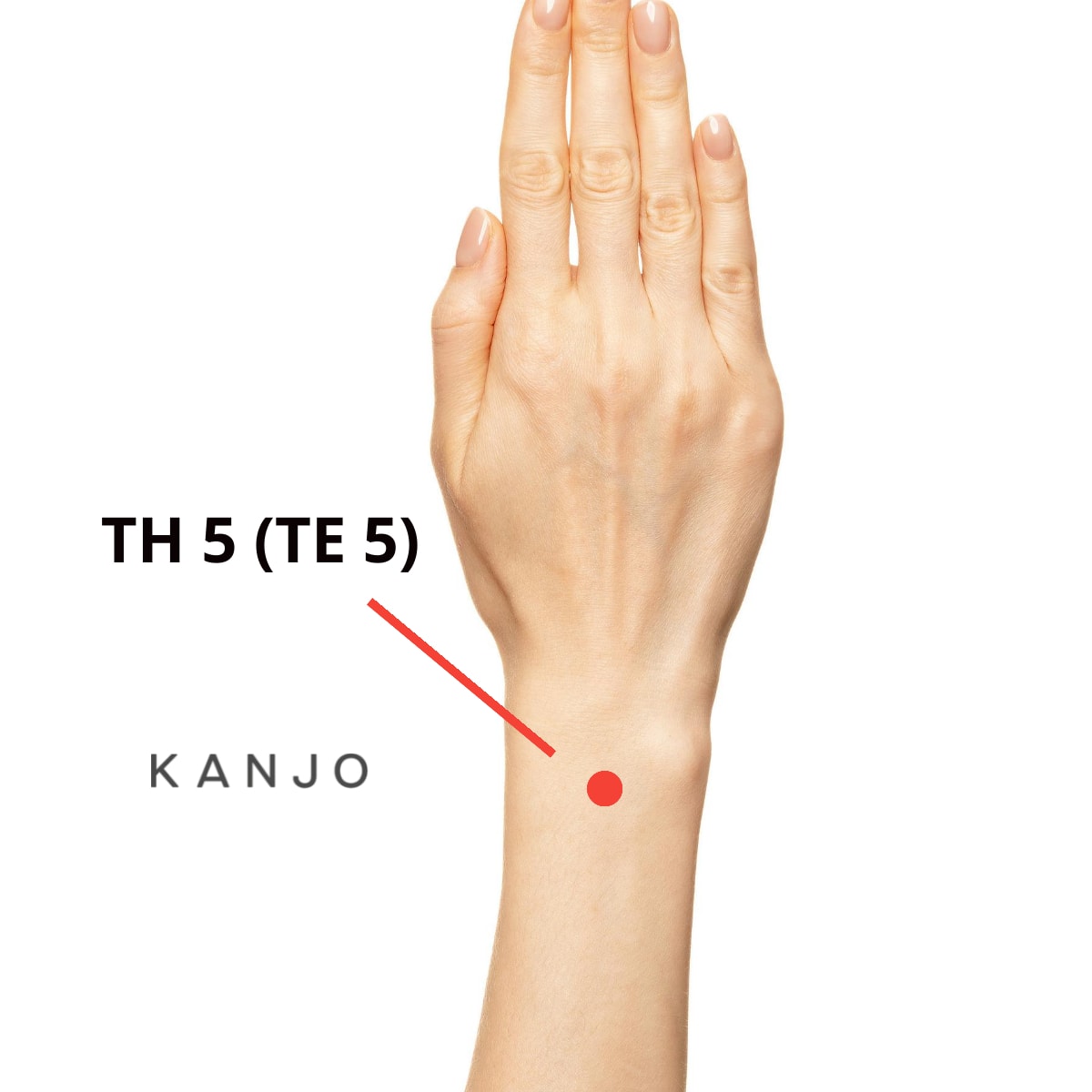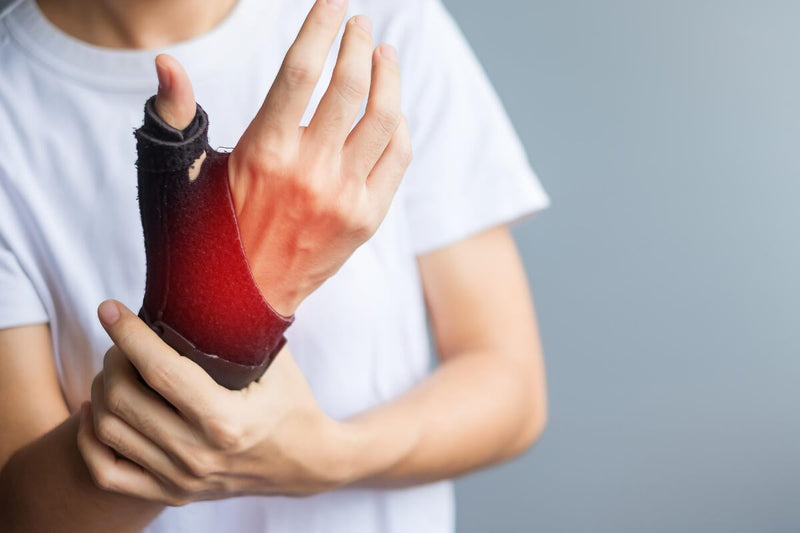Carpal tunnel is incredibly common, affecting approximately 3–6% of adults in the general population.
If untreated, carpal tunnel can worsen over time. It can even lead to permanent damage, including weakness and loss of sensation in the fingers.
Traditionally, carpal tunnel has been treated with corticosteroids and surgery. However, these treatments are not for everyone and can often put people off seeking medical help.
In this article, we’ll discuss an alternative to traditional treatments for carpal tunnel, and how pressure point stimulation can help relieve the symptoms and pain caused by the condition.
What is Carpal Tunnel Syndrome?

Carpal tunnel syndrome is a repetitive strain injury (RSI) condition in the hand and forearm, caused by compression of this median nerve.
The carpal tunnel is formed by your carpal bones, located on the bottom of your wrist, and the transverse carpal ligament, located across the top of the wrist.
This creates an opening, through which your median nerve runs. The median nerve is one of the major nerves to the hand. When squeezed, it can cause numbness, tingling, and pain in the affected arm.
Night symptoms are more common, as many people sleep with their wrists bent. This can further aggravate their median nerve.
Compression of the median nerve can happen if the tunnel narrows or the synovium (the tissue around your flexor tendons) swells, reducing blood supply.
Studies have also shown that women are three times more likely than men to develop carpal tunnel syndrome and it often affects those between 40–50 years old.
If you or your doctor suspect that you may have carpal tunnel syndrome, your doctor may order blood tests, a nerve conduction study or an electromyogram, ultrasound, x-ray, or MRI scan to confirm.
Some of the more traditional treatments of carpal tunnel syndrome include:
- Bracing or splinting the affected hand
- Nonsteroidal anti-inflammatory drugs
- Nerve gliding exercises or physical therapy
- Steroid injections
- Surgery
On the other hand, Traditional Chinese Medicine (TCM) views carpal tunnel as being caused by increased ‘heat’ and ‘damp’ in the wrist. In these terms, it’s thought of as a stagnation of Qi and Blood in the wrist due to Wind, Cold, or Damp.
Treatment, then, tries to move this stagnant Qi and Blood, using the various pressure points surrounding the carpal tunnel.
While this can be achieved through acupuncture, acupressure can also be highly effective in the early stages without puncturing the skin.
12 Carpal Tunnel Pressure Points
By using acupressure to stimulate various acupuncture points associated with carpal tunnel, you can help to relieve the early symptoms of carpal tunnel syndrome.
The following lists and discusses the various known pressure points that may help.
1. Pericardium 6 (PC 6 or P 6) — Neiguan or Inner Frontier Gate

The PC 6 pressure point is located 3 finger widths from your wrist crease, on the inner side of your forearm and wrist.
By stimulating this point and applying pressures, you can relieve carpal tunnel.
Other conditions that the PC 6 pressure point can also be responsible for include insomnia, anxiety, nausea, motion sickness, stomach pain, and indigestion.
2. Pericardium 7 (PC 7 or P 7) — Daling or Great Hill

The PC 7 pressure point is found in the middle of the transverse crease of the wrist, between the tendons of the palmaris longus and flexor carpi radialis.
Stimulation of this particular pressure point can not only relieve carpal tunnel but also cardiac, chest, and hypochondrium pain, palpitations, gastric pain and vomiting, and pain found in the heel.
It has also been known to help relieve the symptoms of manic psychosis.
3. Pericardium 8 (PC 8 or P 8) — Laogong or Labor Palace

The PC 8 pressure point is located in the middle of your palm.
It can be found by using the same motion with your middle finger, as if you were making a fist. Where the tip of your finger meets your palm is the PC 8 pressure point location.
Stimulation of this pressure point by gently rubbing the area with your opposite hand’s thumb relieves carpal tunnel symptoms. But if you're pregnant, be careful as this acupressure point can also help to induce labor.
4. Heart 7 (HT 7) — Shenmen or Spirit Gate

The HT 7 pressure point is found by following your pinkie finger down to the depression in the inner wrist crease.
By placing pressure on this point, you can relieve the symptoms of carpal tunnel, insomnia, anxiety and stress.
Relief of irritability and chest palpitations are also affected by this particular acupressure point.
5. Heart 8 (HT 8) — Shaofu or Lesser Mansion

The HT 8 pressure point is between the 4th and 5th metacarpal bones, on your palm. You can find it more easily by making a fist—where the tip of your little finger touches is the acupressure point.
In addition to relieving symptoms of carpal tunnel syndrome, this pressure point can also relieve spasmodic pain found in your pinkie, palpitations and chest pain.
In TCM, it calms the Shen and clears excess Heat, as well as Heat from both the heart and small intestine.
6. Lung 8 (LU 8) — Jingqu or Channel Canal

The LU 8 pressure point is found on the radial palmar aspect of your forearm, in the depression between the styloid process of the radius and radial artery. It’s located 1 cun (about 1 finger width) above the transverse crease of the wrist.
Pressure on this acupoint will help relieve symptoms of carpal tunnel syndrome and wrist pain, as well as coughs and asthma, chest pain, and sore throats.
7. Lung 9 (LU 9) — Taiyuan or Great Abyss

The LU 9 pressure point is located on the inner wrist crease. You can find it by following your thumb down to your wrist.
Stimulation of this pressure point relieves symptoms of carpal tunnel syndrome and wrist pain, as well as sinus infections, colds, headache, and asthmatic coughs. It can also help with anxiety and palpitations.
8. Lung 10 (LU 10) — Yuji or Fish Border

The LU 10 pressure point is found in the depression behind the thenar eminence of the thumb, where the red and white skin meet at about the midpoint of the palmar side of the thumb.
By stimulating this pressure point, you can relieve the symptoms of carpal tunnel syndrome, as well as a multitude of chest-related ailments. These include asthma, sore throat and hoarseness, coughing, hemoptysis (coughing up blood), and fever.
9. Triple Warmer 5 (TE 5, TH 5, or TB 5) — Waiguan or Outer Pass

The TE 5 pressure point is located 2 finger widths from the wrist crease on the back of the wrist, or outer side of the forearm.
Applying pressure to this particular point will help with carpal tunnel syndrome symptoms as well as pain in the elbow, forearm, wrists and hands.
It has also been known to help relieve migraines and headaches, as well as neck stiffness and pain.
10. Large Intestine 10 (LI 10) — Shousanli or Arm Three Miles

The LI 10 can be found on the outside of your forearm as you bend your arm 90º, just 3 finger widths beneath your elbow crease.
When you apply pressure to this point, you can relieve your carpal tunnel syndrome symptoms, as well as toothaches and swelling of the cheek.
Other issues and conditions that acupressure here can help with include abdominal pain, diarrhea, pain in the shoulder and back, and motor issues and impairment of the upper limbs.
11. Triple Energizer 14 (TE 14 or TB 14)

The TE 3 pressure points are in-between the grooves of your ring finger and pinky on each hand.
Acupressure applied to these points can help with carpal tunnel syndrome, headaches, neck pain, back, and shoulder pain.
12. Large Intestine 15 (LI 15) — Jianyu or Shoulder Bone

The LI 15 pressure point can be found by abducting your arm 90º laterally or forward. It’s then found on the deltoids of your shoulder, within the depression of the anterior superior.
When you apply pressure to this point, you can relieve carpal tunnel syndrome symptoms, as well as any pain or discomfort found in the shoulder joint.
In Chinese medicine terms, it expels Wind-Damp and Wind, as well as circulates Qi in the meridian.
Carpal Tunnel Symptoms
There are a number of carpal tunnel syndrome signs and symptoms that may indicate that you have an issue with your carpal tunnel. If you notice any of them, make sure to seek advice from your healthcare professional.
Symptoms associated with carpal tunnel syndrome include:
- Pain in the wrist or hand
- Pain that travels up your arm and into your shoulder
- Tingling or numbness in your hand or fingers
- Weakness of the hand
- Loss of fine motor movement
- Sudden wrist pain
- Paresthesia (a burning or prickling sensation)
Carpal Tunnel Causes
There are multiple causes of carpal tunnel syndrome. Usually, it isn’t a single factor, but a combination that can lead to the condition.
Further risks for carpal tunnel include:
- Health conditions , such as diabetes, rheumatoid arthritis, and thyroid issues
- Pregnancy, as hormonal changes can cause swelling, putting pressure on your median nerve
- Fluid accumulation states
- Use of contraceptives
- Obesity
- Congestive heart failure
- Nutritional deficiencies
- Vitamin D deficiency
- Smokers
- Excessive consumption of salt, alcohol, or caffeine
- Repetitive hand or finger motions over a prolonged period of time, which can aggravate the tendons and cause swelling
- Menopause
- Gout
- Infections
- Arthritic spurs of the carpal bones
- Tumors
- Ganglion cysts
- Fracture or dislocation of the wrist
- Systemic inflammation
- End-stage renal disease and dialysis
- Acromegaly
- Improper hand and wrist positions over a prolonged period of time, which can increase pressure on the median nerve
- Whether or not traits making you prone to carpal tunnel syndrome run in the family. This is thought to be particularly relevant, as the carpal tunnel may be naturally narrower in some people, which may be hereditary.
Carpal Tunnel Prevention Tips
It hasn’t conclusively been shown that carpal tunnel can be prevented entirely. However, the following has anecdotally been shown to be helpful:
- Doing on-the-job conditioning
- Performing stretching or conditioning exercises
- Using correct posture and wrist positions
- Sleeping with your wrists held straight
- Taking frequent rest breaks from activities which may cause RSI
- Avoiding flexing and extending your wrists repeatedly
- Relaxing your grip and reducing your force during activities that could exacerbate the risk of RSI (eg. typing softly on a keyboard, using a big pen with an oversized, soft-grip adapter when writing)
- Making sure your computer mouse is comfortable and doesn’t strain your wrist
- Wearing fingerless gloves to keep hands warm and flexible
- In manual labor jobs, rotating tasks between workers to avoid repetitive motions
- Wearing a wrist brace to keep your wrist in a neutral position
- Redesigning workstations, tools, and tool handles to enable the workers’ wrist to be able to be in a natural, ergonomic position
Carpal Tunnel Pressure Points Final Thoughts
Carpal tunnel syndrome is one of those things that we don’t really understand well enough to know how to prevent it completely.
It certainly appears that some circumstances predispose you to carpal tunnel syndrome more so than others.
When it comes to pain and discomfort relief, you can try using acupressure to stimulate relief from carpal tunnel.
Sources
- https://www.mayoclinic.org/diseases-conditions/carpal-tunnel-syndrome/symptoms-causes/syc-20355603
- https://orthoinfo.aaos.org/en/diseases--conditions/carpal-tunnel-syndrome
- https://www.hopkinsmedicine.org/health/conditions-and-diseases/carpal-tunnel-syndrome
- https://www.ninds.nih.gov/carpal-tunnel-syndrome-fact-sheet
- https://www.assh.org/handcare/condition/carpal-tunnel-syndrome
- https://www.aafp.org/pubs/afp/issues/2011/0415/p952.html
- https://www.brownmed.com/blog/carpal-tunnel-syndrome/surprising-statistics-about-carpal-tunnel-syndrome
- https://www.ninds.nih.gov/carpal-tunnel-syndrome-fact-sheet

